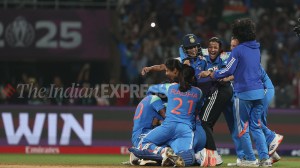Indians are consuming more than the WHO-recommended amount of salt every day, 8 gm instead of five grams across all categories of people, according to a recent survey by the Indian Council of Medical Research (ICMR).
The study, published in the Nature journal, found that salt intake was higher in men (8.9 gm), employed people (8.6 gm) and current tobacco users (8.3 gm). The consumption was also higher than the mean among obese persons (9.2 gms) and those with high blood pressure (8.5 gms). “Reducing salt intake to 5 grams can reduce your high blood pressure by 25 per cent. We need to cut down eating processed foods and those cooked outside home,” said Dr Prashant Mathur, lead author of the study and director of ICMR-National Centre for Disease Informatics and Research.

How can we cut down on salt?
Dr Mathur gives simple guidelines on reducing daily salt intake. “As most of us use salt by habit, we could begin by measuring the amount. Reduce the use of papad, chutney and pickles. Regulations on how much salt can be used in commercially packaged food and informative food labelling can also help. Avoid sprinkling extra salt on your food. Remove that salt shaker,” he says. Of course, one must not go too overboard and ensure sodium levels do not follow below the recommended limit.
What are the common food mistakes we make?
Story continues below this ad
Dr Priyanka Rohatgi, Chief Nutritionist, Apollo Hospitals, calls for junking processed and ultra processed foods for good. “A packet of chips has as much salt as an adult person needs in a day. The same with instant noodles and pre-mixed meals. Couple this intake with your regular meals and you are actually overdosing on salt daily,” she says.
She even lists foods that may not taste salty, are sugary but are high on both salt and sugar. “Watch out for invisible salt in food items like fruit yogurts, cornflakes, cocoa and chocolate-based beverages, aerated and carbonated beverages, preserved or frozen foods. Teens and youngsters gorge on these and develop hypertension and blood pressure early enough, which affects the heart. Pause and look at dietary choices as one of the reasons for heart attacks among the young,” says Dr Rohatgi.
The other most common mistake we make is going for salt substitutes like Lona, available in pharmacies, and commercially made low sodium salt packets. “The makers replace a part of the sodium with potassium. And you consume it without control thinking it is safe. But excess potassium can disturb the rhythm of the heart and trigger arrhythmia. Also, Himalayan or any kind of rock salt have just as much sodium,” says she.
Are there natural salt substitutes?
“Use natural salt substitutes like lemon and its zest, which give a tangy effect and also help bring down blood pressure. Crushed garlic, oregano, black pepper and seasoning make for good coverage in salads. Junk the baking powder, which is high in sodium, and use natural yeast for baking. Sourdough breads are safe. Also, balance salt in your meals. When having dal and curry, keep your rice, salad, roti and curd salt free,” says Dr Rohatgi.
How to reduce salt cravings?
Story continues below this ad
Drinking water on the hour washes out excess salt from the body. Dr Rohatgi suggests drinking water infused with lime, orange and mint to reduce craving. “In fact, salt cravings make you thirsty and are an indicator of magnesium and calcium deficiencies, which need to be corrected,” she says.
How to reduce salt appetite in the young?
As taste buds get addicted to robust flavours easily, doctors advise infants not to take any salt and sugar for the first year of their lives. “Thereafter, puree home-cooked foods and do not pick up any packaged food from the shop shelf. Make fries at home. As for salted nuts, chips and other goodies, do not make them a part of your grocery list. Eliminate them completely and do not give kids meals that you order online,” suggests Dr Rohatgi.

































